Abstract
OBJECTIVES: Shiftwork causes disturbances of the normal sleep-wake cycle and circadian rhythm. There is concern that aging workers have more problems than younger counterparts when the human body clock is disrupted. This review considers issues relating to aging, the circadian body clock, and adjustment to altered sleep-wake schedules. METHODS: Reports on effects of aging on the human body clock were reviewed. Research concerned with adjustment to circadian phase shifts (as occurs in night work) was considered. RESULTS: With aging there is an increased tendency towards morningness which is linked with difficulties in sleeping. The peak time and amplitude of normal circadian rhythms are altered. Tolerance of shiftwork can be linked with social factors as well as adaptation of the body clock. CONCLUSIONS: People habituated to night work seem to have developed mechanisms which allow them to cope with disruptions to lifestyle and the endogenous body clock. Elderly people are more suited to phase advances, as occur in morning workshifts, than to phase delays such as nocturnal work.
Full text
PDF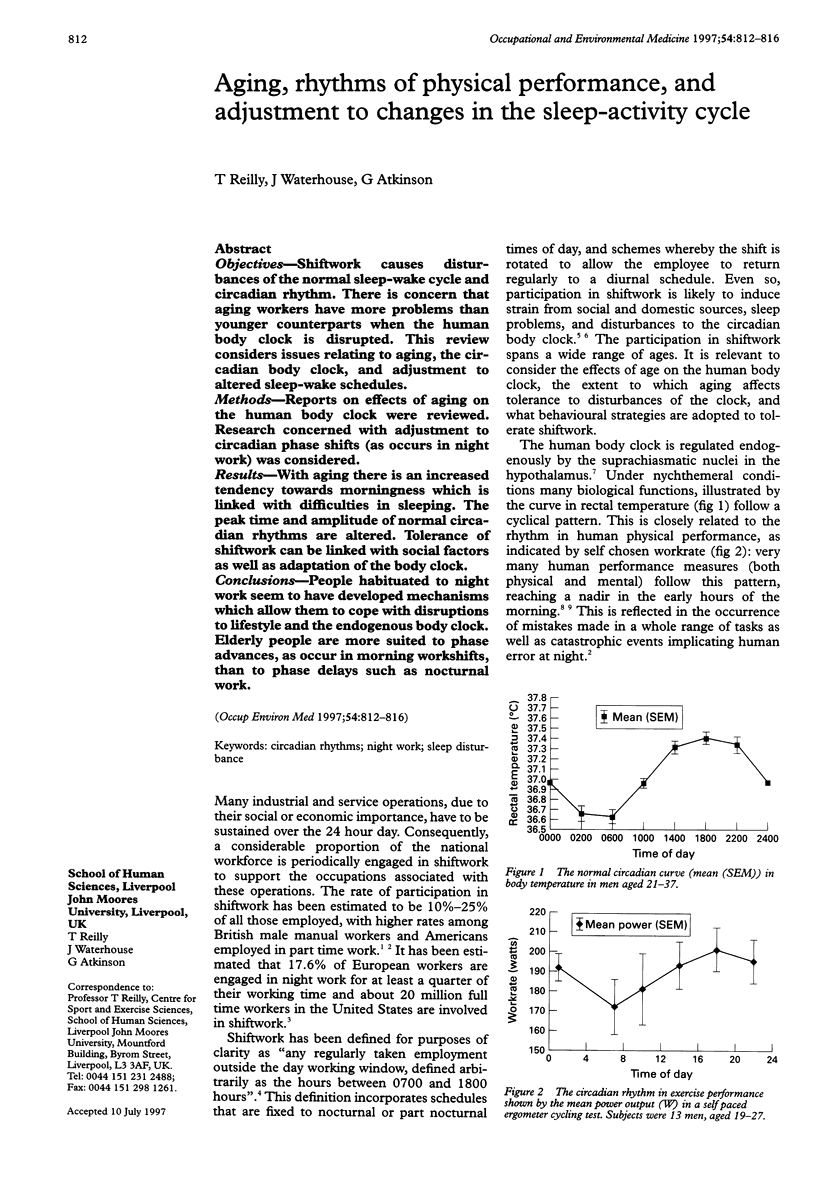
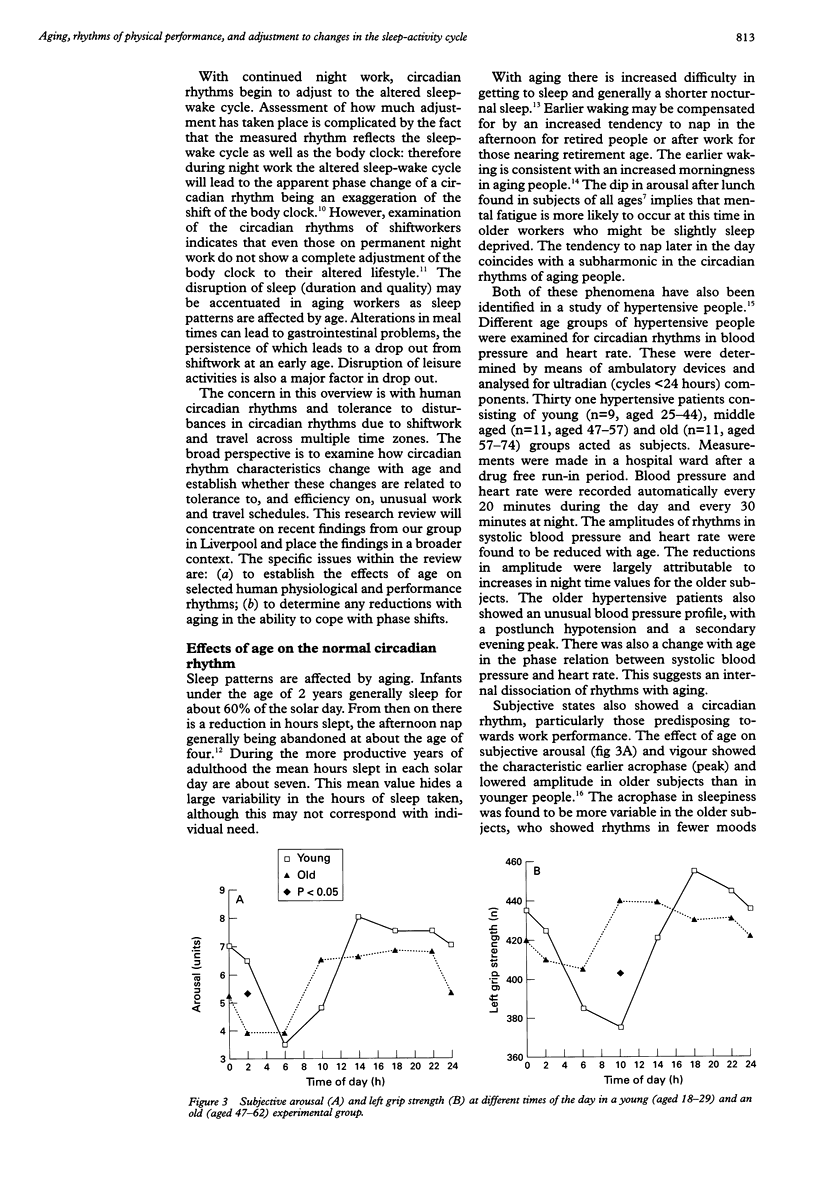
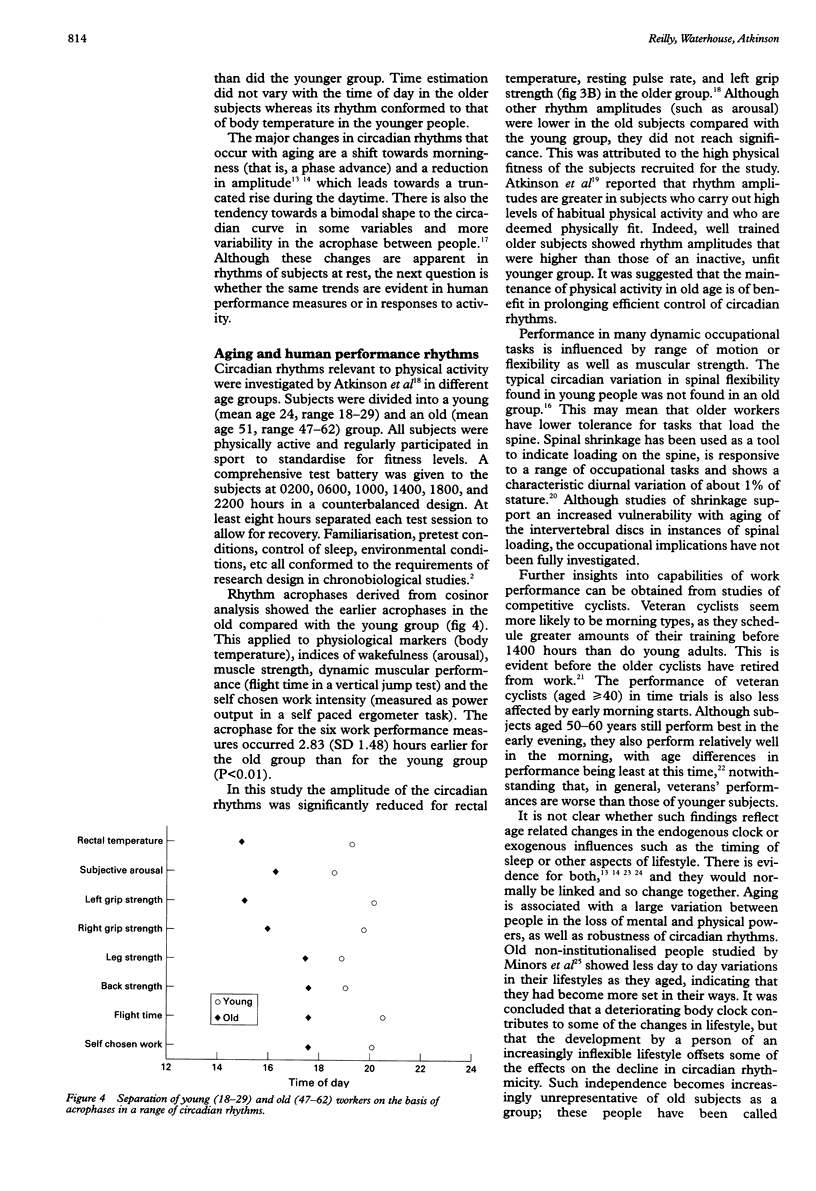
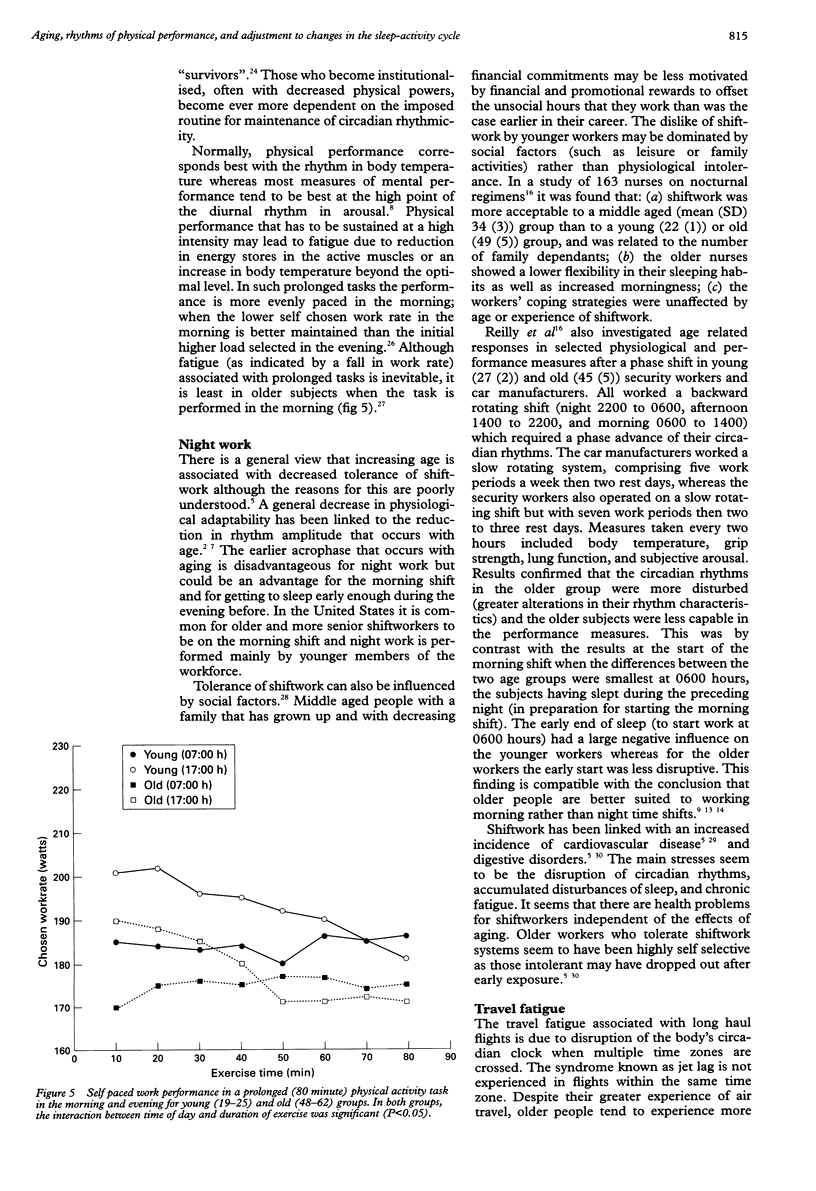
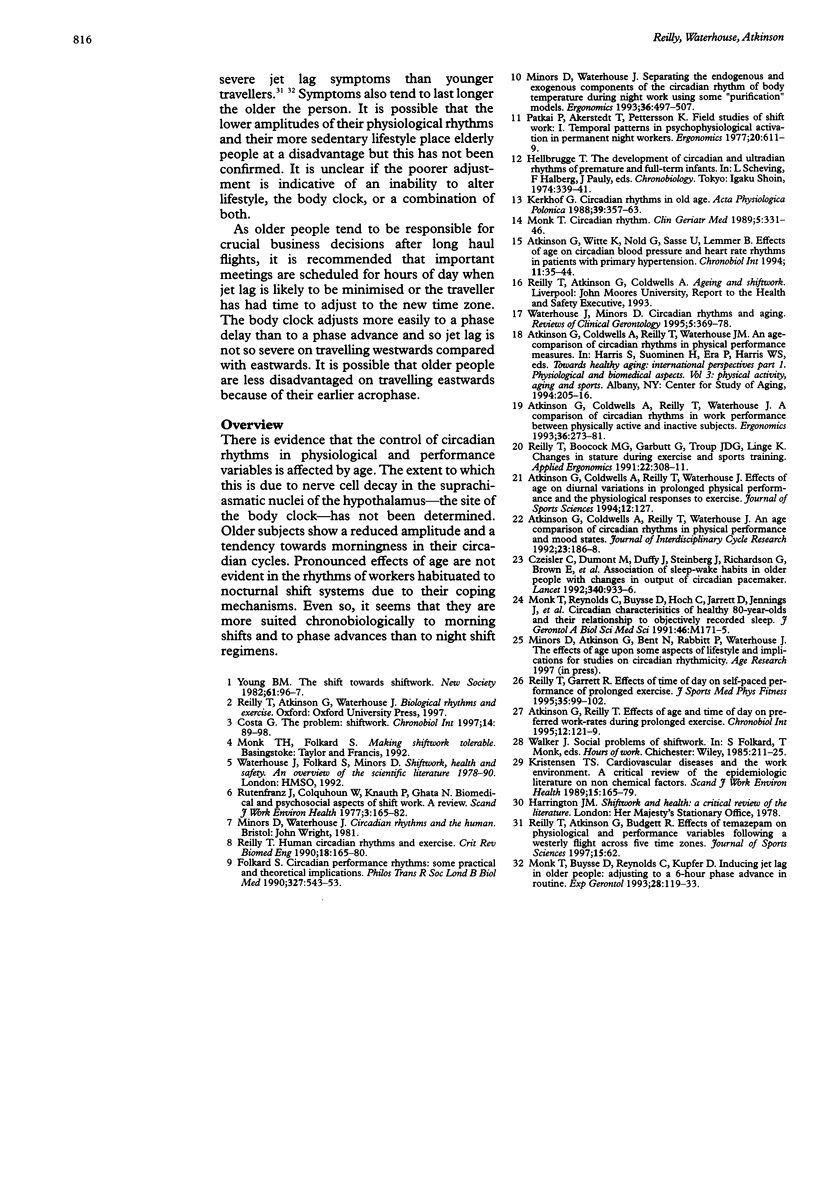
Selected References
These references are in PubMed. This may not be the complete list of references from this article.
- Atkinson G., Coldwells A., Reilly T., Waterhouse J. A comparison of circadian rhythms in work performance between physically active and inactive subjects. Ergonomics. 1993 Jan-Mar;36(1-3):273–281. doi: 10.1080/00140139308967882. [DOI] [PubMed] [Google Scholar]
- Atkinson G., Reilly T. Effects of age and time of day on preferred work rates during prolonged exercise. Chronobiol Int. 1995 Apr;12(2):121–134. doi: 10.3109/07420529509064507. [DOI] [PubMed] [Google Scholar]
- Atkinson G., Witte K., Nold G., Sasse U., Lemmer B. Effects of age on circadian blood pressure and heart rate rhythms in patients with primary hypertension. Chronobiol Int. 1994 Feb;11(1):35–44. doi: 10.3109/07420529409057229. [DOI] [PubMed] [Google Scholar]
- Communications of the annual conference of the British Association of Sports Sciences. Didsbury, Manchester, 4-7 November 1993. Abstracts. J Sports Sci. 1994 Apr;12(2):127–215. doi: 10.1080/02640419408732163. [DOI] [PubMed] [Google Scholar]
- Costa G. The problem: shiftwork. Chronobiol Int. 1997 Mar;14(2):89–98. doi: 10.3109/07420529709001147. [DOI] [PubMed] [Google Scholar]
- Czeisler C. A., Dumont M., Duffy J. F., Steinberg J. D., Richardson G. S., Brown E. N., Sánchez R., Ríos C. D., Ronda J. M. Association of sleep-wake habits in older people with changes in output of circadian pacemaker. Lancet. 1992 Oct 17;340(8825):933–936. doi: 10.1016/0140-6736(92)92817-y. [DOI] [PubMed] [Google Scholar]
- Folkard S. Circadian performance rhythms: some practical and theoretical implications. Philos Trans R Soc Lond B Biol Sci. 1990 Apr 12;327(1241):543–553. doi: 10.1098/rstb.1990.0097. [DOI] [PubMed] [Google Scholar]
- Kerkhof G. A. Circadian rhythms in old age. Acta Physiol Pol. 1988 Sep-Dec;39(5-6):357–363. [PubMed] [Google Scholar]
- Kristensen T. S. Cardiovascular diseases and the work environment. A critical review of the epidemiologic literature on nonchemical factors. Scand J Work Environ Health. 1989 Jun;15(3):165–179. doi: 10.5271/sjweh.1864. [DOI] [PubMed] [Google Scholar]
- Minors D. S., Waterhouse J. M. Separating the endogenous and exogenous components of the circadian rhythm of body temperature during night work using some 'purification' models. Ergonomics. 1993 May;36(5):497–507. doi: 10.1080/00140139308967908. [DOI] [PubMed] [Google Scholar]
- Monk T. H., Buysse D. J., Reynolds C. F., 3rd, Kupfer D. J. Inducing jet lag in older people: adjusting to a 6-hour phase advance in routine. Exp Gerontol. 1993 Mar-Apr;28(2):119–133. doi: 10.1016/0531-5565(93)90002-u. [DOI] [PubMed] [Google Scholar]
- Monk T. H., Reynolds C. F., 3rd, Buysse D. J., Hoch C. C., Jarrett D. B., Jennings J. R., Kupfer D. J. Circadian characteristics of healthy 80-year-olds and their relationship to objectively recorded sleep. J Gerontol. 1991 Sep;46(5):M171–M175. doi: 10.1093/geronj/46.5.m171. [DOI] [PubMed] [Google Scholar]
- Monk T. H. Sleep disorders in the elderly. Circadian rhythm. Clin Geriatr Med. 1989 May;5(2):331–346. [PubMed] [Google Scholar]
- Reilly T., Boocock M. G., Garbutt G., Troup J. D., Linge K. Changes in stature during exercise and sports training. Appl Ergon. 1991 Oct;22(5):308–311. doi: 10.1016/0003-6870(91)90386-v. [DOI] [PubMed] [Google Scholar]
- Reilly T., Garrett R. Effects of time of day on self-paced performances of prolonged exercise. J Sports Med Phys Fitness. 1995 Jun;35(2):99–102. [PubMed] [Google Scholar]
- Reilly T. Human circadian rhythms and exercise. Crit Rev Biomed Eng. 1990;18(3):165–180. [PubMed] [Google Scholar]
- Rutenfranz J., Colquhoun W. P., Knauth P., Ghata J. N. Biomedical and psychosocial aspects of shift work. A review. Scand J Work Environ Health. 1977 Dec;3(4):165–182. doi: 10.5271/sjweh.2777. [DOI] [PubMed] [Google Scholar]


